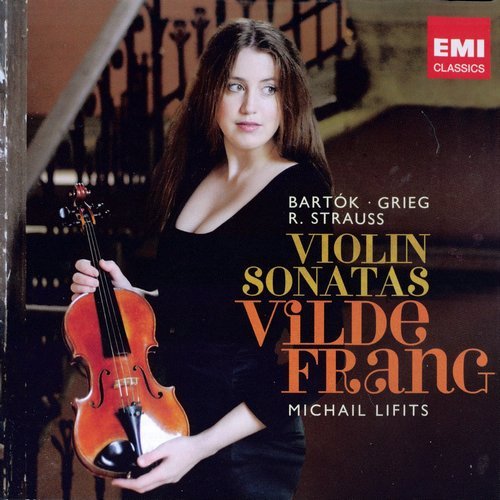Vilde Frang, Michail Lifits - Bartok, Grieg, Strauss - Violin Sonatas (2011)

Artist: Vilde Frang, Michail Lifits
Title: Bartok, Grieg, Strauss - Violin Sonatas
Year Of Release: 2011
Label: EMI Classics
Genre: Classical
Quality: FLAC (image+.cue,log,scans)
Total Time: 78:49
Total Size: 352 Mb
WebSite: Album Preview
Tracklist: Title: Bartok, Grieg, Strauss - Violin Sonatas
Year Of Release: 2011
Label: EMI Classics
Genre: Classical
Quality: FLAC (image+.cue,log,scans)
Total Time: 78:49
Total Size: 352 Mb
WebSite: Album Preview
Edvard Grieg (1843-1907)
[1]-[3] Violin Sonata No.1 in F major, Op.8
Béla Bartók (1881-1945)
[4]-[7] Sonata for Solo Violin
Richard Strauss (1864-1949)
[8]-[10] Violin Sonata in E flat major, Op.18
Performers:
Vilde Frang, violin
Michail Lifits, piano
Following her successful debut album of violin concertos by Jean Sibelius and Sergey Prokofiev, Vilde Frang turns to chamber music for her second release on EMI, in a program of violin sonatas by Edvard Grieg, Béla Bartók, and Richard Strauss. These are not obscure works, but they are infrequently played and less often recorded, so Frang's choices make the disc interesting, as well as a bit of a gamble. Grieg's Violin Sonata No. 1 in F major, Op. 8, is characteristically lyrical and melancholy, despite the piece's predominantly major tonality, and the tunefulness of this youthful work makes it immediately accessible. The Sonata for Solo Violin by Bartók is austere, angular, and harmonically bracing, so listeners who expect a relaxing experience should instead prepare for a challenging modernist work that requires considerable concentration. Strauss' Violin Sonata in E flat major, Op. 18, returns to the sweet melodious strains of Romanticism, yet because it is an early work, it will surprise listeners who don't know that it bears more resemblance to the music of Schumann than to that of the mature Strauss. In the two sonatas for violin and piano, Frang and her accompanist Michail Lifits are completely in accord, and their interpretations of the music are fully realized in robust rhythms, sympathetic exchanges, and long-breathed lines. In the Bartók, Frang carries the music alone, and is thus exposed to the bête noire of solo violin playing, the apparent scratchiness of double and triple stops. These, along with Bartók's strident dissonances and dry expressions, may make this sonata difficult to appreciate on first hearing. But because the sonata places demands on both performer and listener, Frang was bold to include it and deserves credit for an exceptional performance.
![RAS - Rød i Blå (2025) [Hi-Res] RAS - Rød i Blå (2025) [Hi-Res]](https://www.dibpic.com/uploads/posts/2025-12/1765847447_s09xuo23tcu1a_600.jpg)

![Koldo Munné & 1520's Ensemble - Live at Jamboree Live Music (2025) [Hi-Res] Koldo Munné & 1520's Ensemble - Live at Jamboree Live Music (2025) [Hi-Res]](https://www.dibpic.com/uploads/posts/2025-12/1765846749_ck2b0xbsb8jna_600.jpg)



![Mark Northam - More Music From The Pixar Films For Solo Piano (2025) [Hi-Res] Mark Northam - More Music From The Pixar Films For Solo Piano (2025) [Hi-Res]](https://img.israbox.com/img/2025-12/17/qc8ci6ocl25zt4m9ojnjn3k2k.jpg)

